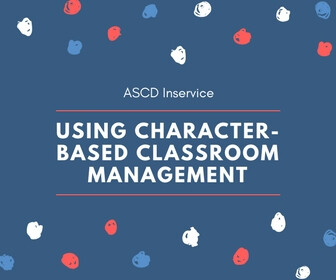You’ve probably heard the phrase, “Put on your own oxygen masks first before assisting others” so often that the truth behind it doesn’t sink in. If you aren’t able to function, you’re of no use to others, but education is a profession that often requires teachers to go above and beyond for their students. Even before the disruption caused by COVID-19, a study reported that the top five emotions teachers would use to describe their profession are frustrated, overwhelmed, stressed, tired, and happy. The same researchers found a slight shift in this list in April, to anxious, fearful, worried, overwhelmed, and sad (Cipriano and Brackett, 2020).
This means that, as a whole, educators may not have enough of what we call “brain bandwidth” to meet the increased needs of students for relationships, healing, encouragement as they adjust to new learning environments, and hard conversations around social justice.
Think of bandwidth as the bucket of energy in your brain that you use to exercise good decision-making, willpower, patience, emotional intelligence, and other high-level executive functions. If you use it up for one of these, it isn’t available for others. If you double down on a tough task—whether it’s staying calm during an emotional exchange, spending an hour on a rigorous academic assignment, or telling yourself over and over that you won’t indulge in the donuts during a long professional development morning—you’re far more likely to lose patience in the next difficult encounter you have, or skip going to the gym, or binge-watch a whole season of The Simpsons. Willpower only takes you so far.
So, what can you do? Learn to do what your brain needs to make that bandwidth bucket as full as possible. Building brain efficiency, effectiveness, and engagement adds up to more time for planning lessons, facilitating learning, and caring for students.
Fueling Your Brain
You won’t be surprised to learn that eating properly, exercising, and sleeping well all contribute to bandwidth—and are often the first areas we cut back on when we feel that we “just don’t have time.” Here are a few incentives and tips to help you avoid this huge trap.
- A power nap—less than 20 minutes—allows you to get more done in 60 minutes than if you fight feelings of fatigue and try to power through the work. We both use the Power Nap app by Sleep Cycle, which wakes you up before you sleep too long. It refreshes the mind without getting you into the deeper phases of sleep that result in grogginess. You are likely to notice improved focus that will recapture the time you feel you may have lost taking a nap.
- Healthy food replenishes the brain.How many steps does it take to get to a good choice vs. a lesser choice? If the only snack in your desk is a single package of almonds, it’s far easier to eat that than to head somewhere else to get a snack. Prepare five healthy lunches on Sunday so you can grab them during the week. Place junk food on a high shelf in a container so that you have to bring over a chair, climb up, use a jar opener, and reverse all the steps to have the peanut butter cups. Extra cognitive steps for junk food!
- Exercise—even a five-minute walk around the block or the hallways—increases willpower significantly. You are increasing circulation to the brain, which has multiple benefits. Look for opportunities to move whenever possible.
Filtering Information
In the digital age—and in the service of delivering the best distance learning or classroom possible—it’s easy to get lost in web searches or Twitter conversations or other quests for the perfect content or tool or question. Wherever you can, have a default decision to filter choices. You’ll free up time and brain energy for important searches you need to expand. Too much information exhausts the brain, causing decision fatigue. Try this:
- Narrow choices in a few areas of life.Try sticking to one or two breakfast choices, for example, the way people order the same beverage every time they stop at a coffee shop.
- Collaborate and borrow.You are not stealing if you use a colleague’s lesson but rather gaining from their experience. Have an honest conversation with your team. Who is energized by which parts of your curriculum? What information would you need to capture and share to feel comfortable using each other’s lessons? Might you trade students for certain content areas—one teaching math and another science at the elementary level, or one handlingOthelloand anotherUncle Tom’s Cabinat the secondary level? What about having more than one class together on Zoom for the content portion of a lesson? One teacher can concentrate on delivery while the other watches the chat room, fields questions, or watches the video feed for signs of engagement? Any of these collaborative practices buy back time for more creativity for all teachers involved.
Focus, Focus, Focus
Our brains have not rewired to deal with digital information and devices; that takes millennia of evolution. Instead, we’ve developed inefficient patterns that are mislabeled multi-tasking. While you can walk and chew gum at the same time out of habit once you’ve learned how, you can’t effectively attend to conversations and answer emails, or work on a lesson plan while listening to a lecture.
Think you can multitask? Try this experiment. Find a piece of paper and ask someone else to time you as you print the words, “I am a world-class multitasker” and the numbers 1-26. How many seconds did it take you?
Now, alternate writing the letters and the numbers while being timed: I, 1, a, 2, m, 3….r, 26. How long did that take? Your brain had to task-switch in between each letter and number. Multitasking is a myth!
If you want to make the most of your time, figure out how to schedule blocks of 30-45 minutes without interruptions and then take breaks. Ignore emails; put cognitive steps in between yourself and your phone if necessary (leave it in another room, turn it off, put it in a box…).
Leaders: Model Self-Care
Whether you’re one of those leaders who truly gets by on five hours of sleep or recovers from a conflict situation with a good game of tennis, know that modeling self-care is essential. Why? If you don’t, those you lead see your extra hours on the job, late-night emailing, lack of lunch breaks, or other lack of life balance behaviors as a mandate for them to do likewise—and most will burn out even faster. Leaders need to model self-care or no one else feels they can take care of themselves (Skakon, et. al., 2010). If the adults don’t have enough brain energy and bandwidth, how can they possibly meet the needs of students when their bandwidth buckets are running on empty?
Fuel your brain, focus your attention, and filter all the information around you. These are three ways to not only have more time for what matters but also to have the energy you need to listen to a child, to percolate your best ideas, and to use your emotional intelligence to handle stress wisely.
References
Cipriano, C. & Brackett, M. (2020). “Teachers are anxious and overwhelmed. They need SEL now more than ever.” Retrieved April 7, 2020 from https://www.edsurge.com/news/2020-04-07-teachers-are-anxious-and-overwhelmed-they-need-sel-now-more-than-ever
Skakon, J., Nielson, K, Borg, V., & Guzman, J. (2010). “Are leaders’ well-being, behaviours and style associated with the affective well-being of their employees? A systematic review of three decades of research.” Work Stress, 24, 107-139
Ann C. Holm, MS, PCC, CPQC, is a professional certified coach specializing in executive, leadership, and personal development. She is an MBTI Master Practitioner and is known as a thought leader in integrating psychological type theory with other coaching models, including Emotional Intelligence, Positive Intelligence, and Polarity Thinking, where she holds certifications. In addition, Holm has 25 years of experience in applied brain science as a speech-language pathologist specializing in stroke and brain injury rehabilitation. She is a frequent podcast guest and coauthor (with Jane Kise) of Educator Bandwidth: How to Reclaim Your Energy, Passion, and Time (ASCD, 2022).








